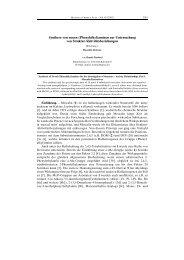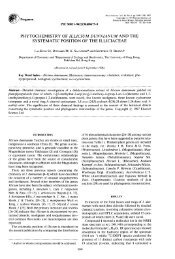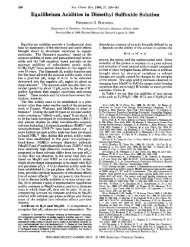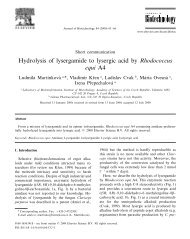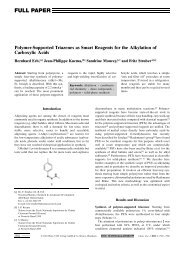Nef reaction
Nef reaction
Nef reaction
Create successful ePaper yourself
Turn your PDF publications into a flip-book with our unique Google optimized e-Paper software.
THE NEF REACTION 153<br />
whether it involves: (1) carbon-oxygen bond formation prior to proton loss from<br />
carbon, (2) proton loss from carbon to give a nitrile oxide,<br />
followed by carbon-oxygen bond formation, or (3) an intramolecular Beckmann-<br />
type rearrangement. Similarly, there is no proof that the transient blue or green<br />
compound of the <strong>Nef</strong> <strong>reaction</strong>, for which the hydroxynitroso structure is fa-<br />
vored, is in reality a true intermediate, rather than an alternate intermediate<br />
or a substance in a side equilibrium with an intermediate. The universality of<br />
the colored compound in the <strong>Nef</strong> <strong>reaction</strong>, however, makes it seem most prob-<br />
able that it is a true intermediate.<br />
E. NITROSATIOK BYPRODUCTS<br />
KO review of the <strong>Nef</strong> <strong>reaction</strong> is complete without an explanation for the<br />
nitrous acid and nitrosation products which are frequently found as byproducts<br />
of the <strong>Nef</strong> (41, 65) and related <strong>reaction</strong>s (3, 15, 24, 43, 63). The formation of<br />
nitrolic acids and pseudonitroles during Kef <strong>reaction</strong>s can be prevented by<br />
having urea present (31, 65), since it rapidly destroys nitrous acid and does<br />
not itself reduce the yield of the <strong>Nef</strong> <strong>reaction</strong> (65).<br />
Russell (52) has reported a careful kinetic study of the oxidation by air of<br />
2-nitropropane in basic solution. The data are consistent with an autocatalytic<br />
ion-radical chain mechanism, which yields principally nitrite ion and acetone,<br />
and small amounts of organic acids, 2 3-dimethyl-2,3-dinitrobutane, and<br />
nitrate ion. Sodio-2-nitropropane is readily oxidized by air at 25°C. in 0.56.0<br />
N aqueous sodium hydroxide, but only a slow absorption of oxygen occurs in<br />
the absence of base or in very concentrated base (-10 M). The oxidation reac-<br />
tion appears fairly general, although sodiophenylnitromethane does not under-<br />
go it. Since the occurrence of this autoxidation <strong>reaction</strong> has not always been<br />
generally realized, few precautions have been taken to exclude air or to use<br />
alkaline solutions of nitroalkanes promptly after preparation. Consequently, it<br />
is not surprising that acidification of such solutions liberates substantial<br />
amounts of nitrous acid and the conditions approximate those used in the prep-<br />
aration of nitrolic acids and pseudonitroles. An application of this autoxidation<br />
<strong>reaction</strong> has been patented by Nygaard, McCracken, and Koland (46, 47, 48,<br />
49) for the preparation from nitroalkanes of nitrolic acids and pseudonitroles,<br />
which have proved effective ignition improvers in Diesel-type fuels.<br />
IV. REFERENCES<br />
BAMBERGER, E.: Chem. Ber. 36, 45 (1902).<br />
BAMBERGER, R., AXD SCHEUTZ, T.: Chem. Ber. 34, 2031 (1901).<br />
BAMBERGER, E., AZID SELIGhiAN, R.: Chem. Ber. 36, 701 (1903).<br />
BARLTROP, J. A., AND KICHOLSON, J. S.: J. Chem. SOC. 1961,2524.<br />
BRASCH, G. E. K., ASD JAxoN-DEEI,x%S, J.: J. Am. Chem. soc. 49, 1765 (1927).<br />
BUCKLEY,<br />
CANOSICA, I,.: Gam. chim. ital. 77, 92 (1947).<br />
COOK, D. J., PIERCE, 0. R., AND MCBEE, E. T.: J. Am. Chem. SOC. 76, 83 (19%).<br />
E., AND R~sT,<br />
G. D., CHARLIBH, hiRS. J. L., ASD ROSE, J. D.: J. Chem. SOC. 1947, 1514.



